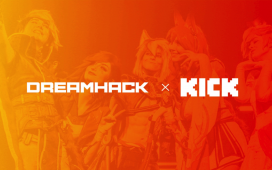As the coronavirus epidemic accelerated, esports had to change. The first sign was when Blizzard canceled its events in China on January 29, to protect the safety of people who gathered at live events at stadiums in China to cheer on their favorite esports stars.
And now, all of the esports events are being canceled at physical venues, whether they’re at small internet cafes, movie theaters, or large stadiums. Fortunately, unlike sporting leagues like the NBA and the NHL, esports teams have the option of pivoting to digital competitions.
The change is wrenching for the people working at the venues and supporting physical events, but esports can permanently benefit and grow from this as well, according to interviews I did with esports company CEOs and other experts this week.
All of life is moving to digital, with people working from isolated homes and sheltering in place. It’s tragic on a global scale, and no one wants to be perceived as taking advantage of this, said Ann Hand, CEO of Super League Gaming, in an interview. But in the name of both preserving and creating new jobs and meaningful new work for people, the esports industry is pivoting. (We’ll be talking about this change at our online-only GamesBeat Summit 2020 event on April 28-29.)

Above: Ann Hand, CEO of Super League Gaming.
Image Credit: Milken Institute
Like many other esports companies, Super League Gaming is not making money on its combined physical and digital businesses, which include holding amateur esports tournaments in movie theaters and running a Minehut community for kids to play Minecraft together.
“You never feel good about talking about bright spots of opportunity when the world is in such a dire place,” Hand said. “But I do take comfort that gaming is bigger than TV and three times the size of the box office, and it’s an important way that people are going to stay socially connected during this time.”
Super League Gaming’s Minehut only-only community has grown from 3,000 concurrent (simultaneous) users during the week to 13,800 users for the past three days. That’s a small crowd, but it’s up 360% in the last two weeks. Viewers for the community’s pages are above 500,000 a day in the last four days, and that’s compared to 150,000 per day in February.
Across the world, esports is growing
Berlin-based G2 Esports is only three years old, and so it built its business for online infrastructure. Adapting to online isn’t as hard, as most of the playing for qualifiers takes place online, with only the finals occurring in person. To deal with the loss of physical events, the company is coming up with different twists to make digital events more interesting.
“Our viewership numbers are going up 30%,” said Carlos Rodriguez, CEO of G2 Esports, in an interview. “It’s unfortunate, as the events are taking place in such a bad time. But it is welcome and unexpected.”
For instance, Spanish pro soccer players Sergio Reguilon and Borja Iglesias played out the canceled real-world Seville derby as a digital event on FIFA 20 (the real match was scheduled to be played on Sunday). G2 Esports content creator, Ibai “Ibai” Llanos, hosted the match and had the opportunity to teach the football stars how to play League of Legends.
At its peak, 62,000 people watched a stream of the game and the streaming numbers of the Seville derby were two or three times greater than usual.
“It’s honestly a nice moment fo companies that rely on content and social media to reinvent themselves and be able to show their community, which happens to be in the real world, and stay relevant to them in the digital world,” said Rodriguez. “Technology becomes more relevant to people, the more time people spend at home. The more time at home, the more entertainment becomes relevant to them. And it’s no accident that Netflix said Fortnite is its biggest competitor.”
The bigger picture for esports

Above: Enthusiast Gaming’s Vancouver Titans
Image Credit: Enthusiast Gaming
On the macro side, it’s clear people need entertainment at home, whether it’s Netflix, porn, TikTok, or video games. A lot of the negative stigma around games as greater slices of the population play.
And so people are turning to games, as Verizon said its online gaming activity is in the U.S. since the coronavirus quarantines went into effect last week. Last weekend, Steam surpassed a record 20 millon concurrent players. And Call of Duty: Warzone, a new battle royale game in the combat series, grew to 16 million players in four days.
Viewership on Twitch is up 10%, and 15% on YouTube Gaming compared to a week ago, according to Doron Nir, CEO of livestreaming tool and service provider SteamElements.
“This past week we saw an increase in livestreaming viewership in Italy and Australia where different approaches have been taken to prevent the spread of COVID-19 (coronavirus),” Nir said in an email. “Based on data from our analytics partner Arsenal.gg, we now have a global snapshot of viewership growth. With more stay-at-home mandates being issued around the world and the entertainment industry finding new ways to migrate their offerings to livestreaming platforms, we expect to see these numbers rise.”
Before the virus hit, M&A advisors at Quantum Tech Partners estimated that esports could hit $4 billion in revenue by 2022, and market researcher Newzoo estimated the total esports audience number would grow to 495 million people in 2020.
The joke is that antisocial gamers have been preparing for this day all of their lives. But the truth is that “games are the new social network,” said Adrian Montgomery, CEO of Enthusiast Gaming, which has a collection of game and esports properties with 150 million users a month. Enthusiast Gaming owns the Luminosity esports team, as well as properties like The Escapist, Sims Resource, and Pocket Gamer.

Above: Super League Gaming
Image Credit: Super League Gaming
“People think that kids in the basement are being antisocial and cooped up in their rooms,” Montgomery said, in an interview. “But the reality is they’re getting online, forging new relationships, making friends with people all across the world, and it’s a social network for them. So in a world that we live in now with social distancing becoming a reality, gaming allows people the opportunity to be social.”
Montgomery said his company’s Sims Resource site doubled in page views from 6 million views to 12 million views in the past week.
In this sense, the coronavirus is accelerating trends that were already pushing gaming and esports forward. And one of the things that is pushing it dramatically now is the absence of traditional sports programming.
“In some ways, this is the opportunity for esports, though I’m not sure it’s the one anybody wanted,” said Kevin Klowden, managing economist and executive director at the Milken Institute’s Center for Regional Economics, in an interview. “Suddenly, the major sports networks have no programming. People actually want to watch games. Nobody is in a better position to take advantage of this, in terms of having content, than esports. Productions are suspended in entertainment for a while.”
And eventually, people are going to get tired of reruns. By contrast, esports fans love to watch the esports pros play games over and over again. The big question is whether the excitement of in-person physical events, with thousands of people roaring at a championship esports match, carry over into a digital-only event without a studio audience?
“Stadiums were an add-on,” Klowden said. “They were nice to have, but they weren’t core to the business model.”
The birth of live esports

Above: The ESL esports finals for Counter-Strike: Global Offensive in Katowice, Poland, in 2017.
Image Credit: ESL
In some ways, esports is returning to its roots in that way, said Craig Levine, chief strategy officer at ESL North America, in an interview. Esports started out as online competitions, and people only started showing up at stadiums starting in 2013. That year, Katowice, Poland’s Spodok arena was home to Intel and ESL’s world championship for esports events for League of Legends and StarCraft II: Heart of the Swarm. 50,000 people turned out, and more than 500,000 watched.
Now the event draws more than 100,000 people in person. And now the live events are canceled.
“This is Back to the Future for us,” Levine said. “Now that there are travel bans, self-quarantining, and social distancing, it was fairly easy for us to be agile and adapt back to online. We created a dynamic and still exciting product.”
But it was still painful. Eleven hours before the Katowice event was supposed to open on February 28, the local government ordered its closure for a live audience. The competition still took place — without 100,000 screaming people in the audience. Still, the Counter-Strike competition for the Intel Extreme Masters World Championship was the most-watched non-major event ever.
“There was definitely a pivot, but with our 20 years of experience, we understood how our products could change and how we could ensure their integrity,” Levine said. “We didn’t miss one day of broadcasts. But I’ll be honest with you. This was uncharted territory. There wasn’t a playbook for” the coronavirus.
Racing to broadcast TV

Above: Darren Cox of Torque Esports, and race car driver Rubens Barrichello at Esports BAR Miami.
Image Credit: Esports BAR Miami
Over in Miami, Torque Esports has a physical business with race car events and a digital business with racing car simulator esports events. And now the company’s All-Star Esports Battle race set a record, and a second one is planned for Saturday with drivers from real Formula 1 races participating in esports competitions.
“Eight days ago, 92% of our business was physical racing, and 8% was esports,” said Darren Cox, CEO of Torque Esports, in an interview. “Now, 87% is esports and 13% is physical. Our digital event took off with a half million views. It was a massive win.”
Cox said his company is holding talks with big media companies about turning the content into television shows on traditional sports networks.
“You have to be respectful of the situation we’re in, but we’re having those conversations,” Cox said. “The revenue model has gone upside down. I never expected to have a revenue line that was called ‘broadcast rights.’ Suddenly, I have to expand my Excel spreadsheet and put a big fat line there. We have people knocking on our door. 10 days ago, that was nonsense.”
Now the question is whether digital-only events will continue for an extended period of time. Without knowing that, it’s hard for anyone to plan in advance. And what happens when traditional sports comes back? Will it supplant the new esports content on broadcast TV?
“Now that we’ve stabilized the ship a little bit, we’re having interesting conversations about how we can create new inventory and new experiences around different game types,” Levine at ESL said. “A trend that is worth watching is the convergence of competitive gaming with more established forms of entertainment. You see labor mobility from film and content, streaming lifestyle content, sports, and gaming.”
Changes for deal makers

Above: Immortals Gaming Club
Image Credit: Immortals
“This is a global pandemic, and there is tons of bad news,” said Ari Segal, CEO of the Immortals esports company. “The reality is there are more people at home, fewer content options, and entertainment has a role to play. Gaming can fill that void. I heard that all Los Angeles Best Buys were out of Xbox Ones. We launched our new Counter-Strike League and the top match had peak concurrent viewership of 100,000.”
That was far higher than other esports events in the past. Sponsorship budgets are being shifted on the fly from traditional sports to esports, Segal said, and media rights for broadcasting are accelerating, as Fox Sports can only show so many reruns before people demand live content.
Segal also believes that esports deal activity will change. Quantum Tech Partners estimated that $1 billion worth of deals were done in 2019, with 33 transactions during the year, with 13 of those involving esports teams.
“For 30 to 90 days, the deal-making will slow,” Segal said. “That said, there will be consolidation. Certain businesses won’t have access to private capital. Their strategic combinations will put businesses in a better position to ride out the storm.”
“We would expect competitive gaming as an industry outperforms other industries in the next several months,” Segal said. “There’s a lot of conversation about gaming. We knew this was an inevitability, but it feels like it has spend up even more than we thought.”
Getting accustomed to digital fans

Above: Complexity Gaming’s new headquarters.
Image Credit: Complexity Gaming
“When you look at this extraordinary circumstance that we have, with traditional sports on hiatus, esports stands alone as being able to continue,” said Jason Lake, CEO of the Complexity esports organization, in an interview. “It’s tough on the event side, with the brick-and-mortar event cancellations. But we can go online and play against each other.”
He added, “We’ve seen a huge uptick in viewership across games. The chosen pastime of this generation is gaming. There’s a unique chance to show a lot of new viewers the product that we have, and that it is compelling.”
Sadly, Complexity built a brand new headquarters last year in Dallas, but its players can no longer use that state-of-the-art facility. But the players can still play their games. But the team has to pay attention to the isolation of players who are normally given an emotional boost by fans who cheer them on in person.
“Still, they can still go online and have 250,000 people watching them now,” Lake said. “Nothing can replace being in a stadium with 20,000 screaming people. But they can go on Twitch and see 100,000 people in the chat session. For now, that will have to suffice.”















